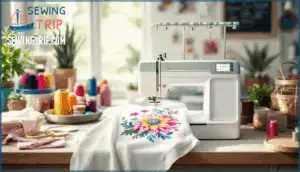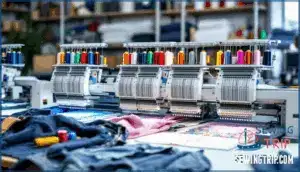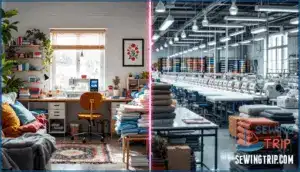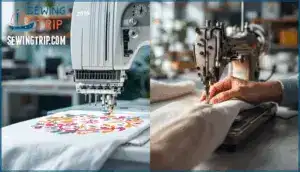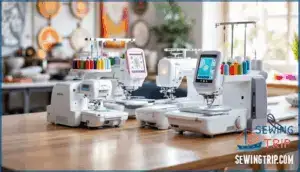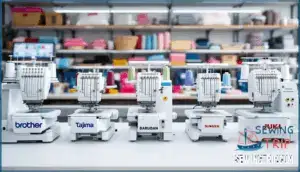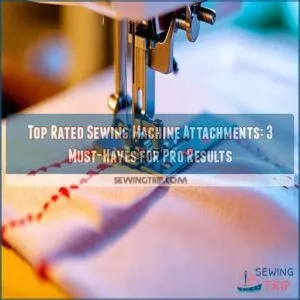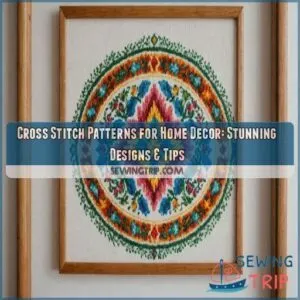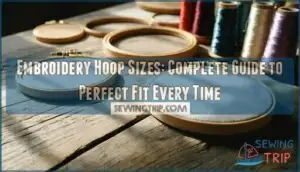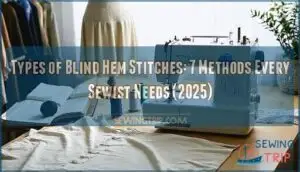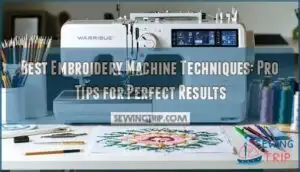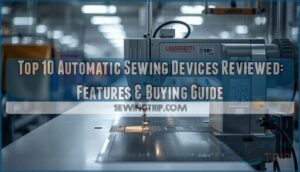This site is supported by our readers. We may earn a commission, at no cost to you, if you purchase through links.
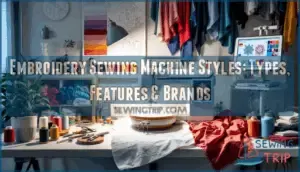
From entry-level single-needle models priced around $500 to industrial multi-needle beasts pushing $20,000, the landscape of embroidery machines splits into distinct categories based on needle count, automation level, and production capacity.
Whether you’re stitching monograms for friends or running a contract embroidery business, understanding how single-needle simplicity stacks up against multi-needle efficiency, or how computerized precision compares to manual control, determines whether your machine becomes a trusted workhorse or an expensive dust collector.
Table Of Contents
Key Takeaways
- Embroidery machines split into distinct categories based on needle count, automation, and production capacity, with single-needle models starting around $400–$800 for beginners and multi-needle commercial units ranging from $6,000–$20,000 for serious production work.
- Multi-needle machines deliver 70% higher output than single-needle setups through automated color changes and faster stitching speeds of 800–1,200 stitches per minute, while AI-integrated models cut thread breaks by 22% and reduce downtime by 30% through real-time diagnostics.
- Stitching speed must balance with fabric type and precision, as heavyweight materials like denim perform best at 600–800 SPM while delicate fabrics require slower 400–600 SPM speeds to prevent puckering, and maintaining proper thread tension prevents the 25% increase in breaks that occurs above 1,000 SPM.
- Modern computerized machines offer sophisticated digitizing options with AI tools that reduce setup time by 70%, support multiple file formats across brands, and provide wireless connectivity, cloud storage, and built-in libraries ranging from 50 designs on entry models to over 500 on commercial units.
Key Types of Embroidery Sewing Machines
When you’re shopping for an embroidery machine, you’ll quickly discover that the market offers a range of styles designed to match different skill levels, budgets, and production goals. Understanding the basic categories helps you zero in on the machine that fits your specific needs, whether you’re stitching custom logos for a sports team or personalizing gifts in your home studio.
Let’s break down the key types you’ll encounter as you explore your options.
Single-Needle Embroidery Machines
If you’re stepping into machine embroidery for the first time, single-needle embroidery machines offer beginner accessibility and cost effectiveness that make them hard to beat. With entry-level models priced between $400 and $800, they deliver solid embroidery machine operation for home applications, small business branding, and individualized projects.
While machine limitations include slower stitching speeds—usually 200 to 800 stitches per minute—and smaller design complexity compared to commercial embroidery equipment, these machines excel at straightforward designs. This lets you master the fundamentals of machine embroidery without overwhelming features or hefty investment.
These machines are seeing increased adoption due to on-demand custom apparel trends.
Multi-Needle Embroidery Machines
When you’re scaling up or handling intricate designs, multi-needle embroidery machines become the workhorse of machine embroidery. These models feature anywhere from 4 to 15 needles, enabling easy color changes without stopping to rethread, and they can stitch between 800 and 1,200 stitches per minute, which translates to serious production efficiency. A 15-needle setup can boost output by up to 70% compared to a 6-needle model, and that kind of speed matters when you’re juggling custom orders or bulk apparel runs.
Modern multi-needle embroidery equipment also brings material versatility to the table, handling everything from delicate silks to tough denim without manual tension adjustments. Hoop capacities averaging 14 × 14 inches let you tackle larger designs, and specialized attachments make cap embroidery or sleeve stitching straightforward. AI-integrated models released since 2024 automatically adjust thread tension and speed based on fabric thickness, cutting thread breaks by 22% in testing environments, while IoT-enabled systems send real-time diagnostics to reduce downtime by roughly 30%. As noted in a recent report, the textile industry’s demand is driving market growth.
Here’s what sets multi-needle embroidery machine operation apart:
- Automated Color Changes – With up to 15 pre-loaded thread colors, you can execute designs with over 20 thread transitions per pattern without pausing, keeping your workflow smooth and reducing manual intervention.
- Material Adaptability – Professional-grade units support over 25 material presets, from 65 Nm needles for silk to 100 Nm for leather, ensuring consistent stitch density across multi-layer fabrics and diverse project types.
- Smart Technology Integration – AI-driven stitch optimization and wireless design transfers via Wi-Fi or USB improve embroidery machine operation, while predictive maintenance algorithms extend machine lifespan by 25% over continuous usage.
Multi-needle machines now represent about 63% of commercial embroidery systems sold globally, with prices ranging from $6,000 to $18,000 depending on needle count and automation level. Market performance remains strong, driven by on-demand customization and sportswear branding, and forecasts.
Commercial Vs. Home Embroidery Machines
When comparing commercial and home embroidery machines, you’ll notice dramatic differences in production volume, stitching speed, and machine cost. Commercial units run 800–1,200 stitches per minute and handle multi-head setups for bulk orders, while home models average 400–800 stitches per minute and focus on personal projects.
Tajima embroidery machines and similar commercial equipment support complex digitizing and design complexity, priced from $8,000 to over $20,000. In contrast, home machines range $500–$3,000 and suit hobbyists with lower user skill requirements.
Computerized and Manual Models
Beyond machine class, you’ll choose between computerized and manual models, which differ in automation benefits and user skill demands. Computerized embroidery machines offer stitching precision up to 1,000 stitches per minute, AI-driven error detection, and cloud-based digitizing, boosting productivity by 40% while cutting labor time.
However, maintenance needs and cost comparisons favor manual units, priced under $1,000, for basic sewing and weaving tasks requiring minimal needle adjustments.
Features and Capabilities of Each Style
Once you’ve selected your embroidery machine style, you’ll need to understand what each one can actually do, because the differences between models can dramatically impact your project outcomes and workflow efficiency.
The capabilities of these machines vary widely, from how fast they stitch to how much creative control you’ll have over your designs. Let’s break down the core features that define what each style brings to the table.
Stitching Speed and Precision
When it comes to the custom embroidery process, stitching speed and precision act like two sides of the same coin, demanding careful balance throughout your digitized embroidery design workflow. Commercial machines generally run between 1,000–1,300 stitches per minute, while home units operate at a gentler 400–800 SPM, and this speed-versus-quality tradeoff shapes everything from tension consistency to the final needlework appearance. Here’s what you need to watch for:
- Fabric considerations matter immensely—heavyweight materials like denim perform best at 600–800 SPM, whereas delicate silk requires slower speeds around 400–600 SPM to prevent puckering and distortion.
- Tension consistency relies on maintaining bobbin thread tension between 18–22 gram-force for home machines and 25–30 gf for commercial units, with speeds above 1,000 SPM increasing thread breaks by up to 25%.
- Automation impact through computerized systems delivers real-time monitoring and sensor-controlled motion tracking, achieving ±0.1 mm stitch placement accuracy while precision maintenance protocols schedule recalibration after every million stitches.
Variable speed control and multi-needle systems reduce manual error considerably, ensuring your weaving and needlework remain consistent even during complex designs.
Hoop Sizes and Design Area
How do hoop dimensions impact your embroidery design work, and what stitchable area can you actually count on for different machine types? Most machines accommodate hoops from 4 × 4 inches—ideal for logos and monograms—up to 8 × 12 inches for jacket backs and larger motifs.
Though the usable embroidery field runs about 3–8% smaller than the stated hoop size due to machine calibration margins and edge constraints, machine compatibility dictates design efficiency. Your stitches must align with manufacturer-published embroidery area specifications and measurement standards to avoid registration errors, fabric pull, and thread tension distortion that compromise your weaving precision.
Customization and Digitizing Options
Why settle for generic designs when you can transform any vision into embroidered reality through sophisticated digitizing options? Modern machines support multiple design filetypes—PES, DST, EXP, and JEF—ensuring software compatibility across brands like Brother PE-Design, Wilcom Hatch, and Embrilliance, which convert your digitizing artwork with stitch-level precision.
AI digitizing tools now slash setup time by 70%, automating border detection and thread sequencing while you adjust:
- Color palettes across 60+ thread charts for instant swaps
- Font libraries featuring 140–200 typography styles with kerning control
- Monogram scaling up to 400% without distortion
- Wireless transfers via Bluetooth or Wi-Fi on 65% of post-2021 models
- Cloud storage and metadata tracking for repeatable digitizing design files
Whether you’re running a digitizing program in-house or outsourcing digitizing services, these customization features let you edit, rotate, and layer design elements on touchscreens up to 10.1 inches, storing 500 patterns and roughly 150MB of user-generated content for instant recall.
Built-in Design Libraries
Think of built-in libraries as your creative springboard—entry-level embroidery machines ship with 50 to 80 embroidery designs, while commercial models offer over 500 motifs plus 300 font support styles spanning Asian and Eastern European scripts.
You’ll find editing tools for resizing, rotation, and color swaps on touchscreen interfaces, and library updates arrive via USB or cloud sync, with design licensing packs priced $5 to $50 for premium logo design collections.
Import digitizing design files in PES, JEF, or DST formats to expand design variety beyond factory libraries, storing hundreds of digitizing artwork patterns for weaving distinctive embroidery into every project.
Popular Brands and Model Comparisons
When you’re ready to invest in embroidery equipment, you’ll find a handful of brands that dominate the market, each offering distinct advantages depending on your production needs and budget. Brother, Tajima, Barudan, Singer, and Juki have built strong reputations through decades of innovation, reliability, and support, making them the go-to names for both home crafters and commercial operators.
Let’s break down what each brand brings to the table so you can make an informed decision.
Brother Embroidery Machine Styles
Brother has carved out significant market share—up 14% in 2025—by offering machines that scale from hobbyist to small business needs, blending user experience with connectivity features that feel genuinely easy to grasp. Whether you’re threading your first logo embroidery project or digitizing software-driven custom embroidery designs, Brother’s lineup speaks directly to makers who want reliability without the learning curve of industrial gear.
| Model Type | Key Features | Price Range |
|---|---|---|
| Single-Needle (PE535, SE700) | 4" x 4" field, 650–850 SPM, 135 designs, manual thread changes | $379–$600 |
| Multi-Needle (PR1055X) | 10 needles, 8" x 8" field, 1,000 SPM, automated color transitions, camera positioning | $9,999–$14,000+ |
| Combination Home Models (SE1900, SE2000) | Sewing + embroidery, 5" x 7" field, 240 stitches, Wi-Fi/Artspira app, touchscreen LCD | $600–$2,500 |
| Commercial PR-Series | Continuous 8+ hour operation, automated trimming, industrial throughput, Picking the right embroidery machine means matching its capabilities to your actual workflow, budget, and creative ambitions—not chasing flashy features you’ll never use |
Whether you’re launching a small business, running high-volume production, or just exploring individualized crafting at home, understanding what to prioritize will save you time, money, and plenty of headaches down the road.
Let’s walk through the key factors that’ll help you make a confident, informed choice.
Matching Machine Features to Your Needs
When you’re choosing between embroidery services and facilities, you need to match features to what you’ll actually create, because buying a machine loaded with capabilities you won’t use is like stocking color threads you’ll never stitch. Start by evaluating these priorities on your control panel:
- Design flexibility: Over 80% of machines in 2025 offer wireless transfers and built-in libraries with 80–250 patterns, cutting start-up time by 40%.
- Cost balance: Entry models begin around $500, while multi-needle commercial units exceed $10,000, so choose features that reduce waste and extend lifespan by 25%.
- Usability prioritization: Automatic threading and touchscreen tutorials slash training time by 50%, improving thread management and workflow precision.
- Project scope: Single-needle accommodates individual work; multi-needle increases efficiency by 70% for complex designs, and understanding long-term efficiency means selecting adaptable technology that grows with your ambitions.
Assessing Production Volume and Fabric Types
Pair your machine speed effects with fabric thread count and weight to reveal production volume metrics that matter—single-head units produce 3–4 garments per hour at 800 stitches per minute, while multi-head systems achieve 13–14 pieces under identical conditions.
For apparel decoration and T-shirt embroidery, match fabric preparation to weave type effects: cotton twill (250–350 TPI) enables heavy embroidery, polyester blends (200–300 TPI) excel in sportswear, and thread management improves when medium-weight woven fabrics minimize distortion and optimize throughput across your embroidery workflow.
Evaluating User Experience and Support
Usability satisfaction starts with the learning curve—Ricoma machines average 4.5/5 ratings across 1,300+ reviews, yet new operators face tension adjustments accounting for 3.27% of complaints, while experienced users achieve 30% higher efficiency after 50 hours of practice.
Your customer service expectations should include maintenance support like one-year free tune-ups, live training resources, and real-time troubleshooting that reduces downtime by 40%, ensuring your logo, artwork, and design execution maintains brand reputation through consistent customer service quality.
Future Trends in Embroidery Machine Technology
AI Integration is reshaping what’s possible—Brother’s Aveneer EV1 converts images to stitches in under 30 seconds, while machine-learning algorithms predict thread breaks to boost efficiency by 30%, making T-Shirt Embroidery and custom apparel and branding faster and smarter. You’ll also see these game-changing shifts:
- Digital Connectivity permits remote monitoring via Wi-Fi and mobile apps, cutting setup time by 50% for high-quality printing and embroidery operations.
- Sustainable Practices like energy-efficient motors and recycled threads reduce costs by 40% while supporting eco-conscious custom printing and embroidery.
- Smart Textiles using conductive threads open doors to e-textile production for wearables, expanding beyond embroidery for special events into medical and fitness applications.
Industrial Performance keeps climbing with machines hitting 1,400 stitches per minute.
Frequently Asked Questions (FAQs)
What maintenance do embroidery machines require regularly?
An ounce of prevention beats a pound of cure, so you’ll want to clean and oil your machine twice yearly if you’re running it over 15 hours weekly. Replacing needles every 6-8 hours will prevent fabric damage, and adjusting tension ensures crisp logo artwork on garments.
Additionally, clearing lint from bobbin and hoop areas and maintaining proper weaving mechanics are essential for special events embroidery.
How long does learning embroidery machine operation take?
Most hobbyists grasp basic embroidery machine operation within three to six hours, though mastering complex logo artwork on garments like T-shirt embroidery or embroider polo shirts demands weeks of practice.
Your prior experience, design complexity, resource quality, and practice frequency directly shape your learning curve.
Can embroidery machines handle thick or delicate fabrics?
Who knew fabric could be so dramatic? Too thick, and your machine throws a tantrum; too delicate, and it’s a disaster.
Modern embroidery machines handle both extremes beautifully when you nail the basics: needle size matters for silk or denim, tension control prevents puckering, stabilizer types support fabric thickness limits, and presser foot choice ensures smooth stitching for custom apparel and embroidered jackets alike.
What file formats work with most embroidery machines?
Most embroidery sewing machines accept DST format, the universal standard storing stitch data without thread color information, and PES files, which retain color instructions for automated changes.
EXP editing allows design resizing, while JEF limitations restrict compatibility to specific brands, making file conversion essential for custom design production.
Do embroidery machines come with warranty coverage options?
When you invest in equipment for high-quality printing and embroidery, warranty duration usually spans one to two years for standard coverage. Extended warranties can stretch that protection up to ten years, safeguarding your apparel customization operation against unexpected repair costs and downtime.
This extended protection ensures that your garment decoration projects, including embroidered t-shirts and T-Shirt Embroidery work, remain uninterrupted, allowing you to focus on delivering quality results without worrying about unforeseen issues.
Conclusion
The embroidery industry sees 40% of new buyers purchasing the wrong machine type for their actual production needs, mistaking hobby-grade features for commercial capabilities. Your choice among embroidery sewing machine styles ultimately hinges on whether you’re threading a path toward creative exploration or building a revenue-generating operation.
Single-needle patience meets your weekend projects, while multi-needle automation fuels your business ambitions. Match your machine’s specifications to your fabric types, volume demands, and growth trajectory, because the right equipment doesn’t just execute designs—it transforms your embroidery vision into tangible reality.
- https://www.precedenceresearch.com/embroidery-machine-market
- https://www.maximizemarketresearch.com/market-report/embroidery-equipment-market/148403/
- https://www.archivemarketresearch.com/reports/sewing-embroidery-machines-488707
- https://maggieframestore.com/blogs/maggieframe-news/barudan-2-head-embroidery-machine-price-guide-2025-costs-roi-buyers-checklist
- https://swpea.com/blogs/machine-embroidery-blogs/brief-history-machine-embroidery

